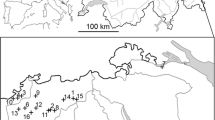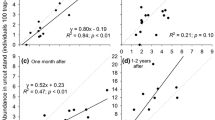Abstract
Context
For wildlife dependent on mature forest living in managed landscapes, habitat loss from land use can outpace habitat recovery from forest regrowth, challenging persistence of habitat specialists. For some species, the effects of habitat loss or fragmentation may also differ between sexes when physiological or behavioral differences influence space use.
Objectives
We evaluated differences in landscape-scale occurrence, as a function of habitat amount and configuration, between male and female American martens in the heterogeneous, commercial forestlands of northern Maine, USA.
Methods
Using location data from a long-term (1994–1997) radio-telemetry study, we modeled boundaries of home ranges occupied by resident adults (> 1 year) and simulated potential home ranges in unoccupied areas. Landscape metrics of habitat amount and configuration within home ranges, calculated from time-specific maps of suitable habitat derived from Landsat satellite imagery, were used to develop binary logistic regression models that were compared within an information theoretic framework. We extrapolated and tested top performing models in two novel landscapes.
Results
Habitat amount was most important when predicting female occurrence. For males, which maintained larger home ranges, occurrence was influenced by habitat amount and patchiness (density and shape). Top sex-specific models reliably predicted marten occurrence (1991–1996) in an adjacent forest preserve, but overestimated occurrence, particularly for females, in a more distant (~ 70 km Northeast) commercial forest in 2007.
Conclusions
Marten in our study exhibited nonlinear declines in occurrence as suitable habitat declined. Maintaining sufficient habitat to support adult females in particular will be important to the future conservation of this late breeding, area sensitive, habitat specialized species.




Similar content being viewed by others
Data availability
Data are available via the Dryad Digital Repository (https://doi.org/10.5061/dryad.sn02v6x5g) (Simons-Legaard et al. 2022).
References
Aune KE, Schladweiler P (1997) Age, sex structure, and fecundity of the American marten in Montana. In: Proulx HN, Woodard PM (eds) Martes: Taxomony, Ecology, Techniques, and Management. Edmonton, Provincial Museum of Alberta, pp 61–77
Bissonette JA, Harrison DJ, Hargis CD, Chapin TG (1997) The Influence of Spatial Scale and Scale-Sensitive Properties on Habitat Selection by American Marten. In: Bissonette JA (ed) Wildlife and landscape ecology: Effects of pattern and scale. Springer, New York, pp 368–385
Borman FH, Likens GE (1979) Catastrophic disturbance and the steady state in the northern hardwood forests. Am Sci 67(6):660–669
Broomhall LS, Mills MGL, du Toit JT (2003) Home range and habitat use by cheetahs (Acinonyx jubatus) in the Kruger National Park. J Zool 261:119–128
Brown ML, Canham CD, Murphy L, Donovan TM (2018) Timber harvest as the predominant disturbance regime in northeastern U.S. forests: effects of harvest intensification. Ecosphere 9(3):e02062
Bull EL, Heater TW (2000) Resting and denning sites of American martens in northeastern oregon. Northwest Sci 74(3):179–185
Bull EL, Heater TW (2001) Survival, causes of mortality, and reproduction in the American Marten in Northeastern Oregon. Northwest Nat 82(1):1–6
Buskirk SW, McDonald LL (1989) Analysis of variability in home-range size of the American Marten. J Wildl Manag 53(4):997–1004
Buskirk SW, Forrest SC, Raphael MG, Harlow HJ (1989) Winter resting site ecology of marten in the central rocky mountains. J Wildl Manag 53(1):191–196
Calenge C (2006) The package “adehabitat” for the R software: a tool for the analysis of space and habitat use by animals. Ecol Model 197(3):516–519
Canham CD, Rogers N, Buchholz T (2013) Regional variation in forest harvest regimes in the northeastern United States. Ecol Appl 23(3):515–522
Chapin TC, Harrison DJ, Phillips DM (1997) Seasonal habitat selection by marten in an untrapped forest preserve. J Wildl Manag 61:707–717
Chapin TG, Harrison DJ, Katnik DD (1998) Influence of landscape pattern on habitat use by American marten in an industrial forest. Conserv Biol 12(6):1327–1337
Clare J, McKinney ST, Simons-Legaard EM, DePue JE, Loftin CS (2019) Satellite-detected forest disturbance forecasts American marten population decline: the case for supportive space-based monitoring. Biol Cons 233:336–345
Conde DA, Colchero F, Zarza H, Christensen NL, Sexton JO, Manterola C, Chávez C, Rivera A, Azuara D, Ceballos G (2010) Sex matters: modeling male and female habitat differences for jaguar conservation. Biol Cons 143(9):1980–1988
Desrochers A, Renaud C, Hochachka WM, Cadman M (2010) Area-sensitivity by forest songbirds: theoretical and practical implications of scale-dependency. Ecogr 33(5):921–931
Fletcher RJ Jr, Reichert BE, Holmes K (2018) The negative effects of habitat fragmentation operate at the scale of dispersal. Ecology 99(10):2176–2186
Fortin C, Cantin M (2004) Harvest Status, Reproduction and Mortality in a Population of American Martens in Québec, Canada. In: Harrison DJ, Fuller AK, Proulx G (eds) Martens and fishers (Martes) in human-altered environments. Springer, Berlin, pp 221–234
Fuller AK, Harrison DJ (2005) Influence of partial timber harvesting on American martens in north-central Maine. J Wildl Manag 69(2):710–722
Groffman PM, Baron JS, Blett T, Gold AJ, Goodman I, Gunderson LH, Levinson BM, Palmer MA, Paerl HW, Peterson GD, LeRoy Poff N, Rejeski DW, Reynolds JF, Turner MG, Weathers KC, Wiens J (2006) Ecological thresholds: the key to successful environmental management or an important concept with no practical application? Ecosystems 9:1–13
Hargis CD, McCullough DR (1984) Winter diet and habitat selection of marten in Yosemite national park. J Wildl Manag 48(1):140–146
Hargis CD, Bissonette JA, Turner DL (1999) The influence of forest fragmentation and landscape pattern on American martens. J Appl Ecol 36(1):157–172
Hodder DP, Larsen KW, Crowley SM (2018) Effects of scale and gender on winter habitat selection by American mink. Am Midl Nat 179:261–274
Hodgman TP, Harrison DJ, Katnik DD, Elowe KD (1994) Survival in an Intensively trapped marten population in maine. J Wildl Manag 58(4):593–600
Hodgman BJ, Harrison DJ, Phillips DM, Elowe KD (1997) Survival of American marten in an untrapped forest preserve in Maine. In: Proulx G, Bryant HN, Woodward PM (eds) Martes: Taxonomy, ecology, techniques, and management. Edmonton, Provincial Museum of Alberta, pp 86–99
Johnson DH (1980) The comparison of usage and availability measurements for evaluating resource preference. Ecology 61(1):65–71
Katnik DD, Harrison DJ, Hodgman TP (1994) Spatial relations in a harvested population of marten in maine. J Wildl Manag 58(4):600–607
Keinath DA, Doak DF, Hodges KE, Prugh LR, Fagan W, Sekercioglu CH, Buchart SHM, Kauffman M (2017) A global analysis of traits predicting species sensitivity to habitat fragmentation. Glob Ecol Biogeogr 26(1):115–127
Laliberte AS, Ripple WJ (2004) Range contractions of North American carnivores and ungulates. Bioscience 54(2):123–138
Lande R (1987) Extinction thresholds in demographic models of territorial populations. Am Nat. https://doi.org/10.1086/284734
Legaard KR, Sader SA, Simons-Legaard EM (2015) Evaluating the impact of abrupt changes in forest policy and management practices on landscape dynamics: analysis of a Landsat image time series in the Atlantic Northern forest. PLoS ONE 10(6):e0130428
McCaskill, G.L., Albright, T., Barnett, C.J., Butler, B.J., Crocker, S.J., Kurtz, C.M., McWilliams, W.H., Miles, P.D., Morin, R.S., Nelson, M.D., Widmann, R.H., & Woodall, C.W. (2016). Maine’s forests 2013. Resour. Bull. NRS- 103. Newtown Square, PA: U.S. Department of Agriculture, Forest Service, Northern Research Station. (p 103)
Mead AR (1994) Reproduction in Martes. Martens, Sables, and Fishers. Biology and Conservation Cornell University Press, Ithaca, pp 404–422
Oliveira T, Urra F, López-Martín JM, Ballesteros-Duperón E, Barea-Azcón JM, Moléon M, Gil-Sánchez JM, Alves PC, Díaz-Ruíz F, Ferreras P, Monterroso P (2018) Females know better: sex-biased habitat selection by the European wildcat. Ecol Evol 8(18):9464–9477
Payer DC, Harrison DJ (2003) Influence of forest structure on habitat use by American marten in an industrial forest. For Ecol Manage 179:145–156
Payer DC, Harrison DJ, Phillips D (2004) Territoriality and home-range fidelity of American martens in relation to timber harvesting and trapping. In: Harrison DJ, Fuller AK, Proulx G (eds) Martens and fishers (Martes) in human-altered environments an international perspective. Springer, New York, NY, USA, pp 99–144
Payer DC (1999) Influences of timber harvesting and trapping on habitat selection and demographic characteristics of American marten. Ph.D. dissertation. University of Maine, Orono
Phillips DM (1994) Social and spatial characteristics, and dispersal of marten in a forest preserve and industrial forest. University of Maine, Orono
Phillips DM, Harrison DJ, Payer DC (1998) Seasonal changes in home-range area and fidelity of martens. J Mammal 79(1):180–190
Pop MI, Iosif R, Miu IV, Rozylowicz L, Popescu VD (2018) Combining resource selection functions and home-range data to identify habitat conservation priorities for brown bears. Anim Conserv 21(4):352–362
Potvin F, Belanger L, Lowell K (2000) Marten habitat selection in a clearcut boreal landscape. Conserv Biol 14(3):844–857
Pulliam HR, Danielson BJ (1991) Sources, sinks, and habitat selection: a landscape perspective on population dynamics. Am Nat 137:S50–S66
Roloff GJ, Silet BR, Gray SM, Humphreys JM, Clark EM (2020) Resource use by marten at fine spatial extents. Mammal Res 65(4):655–665
Sandell M (1989) The mating tactics and spacing patterns of solitary carnivores. In: Gittleman JL (ed) Carnivore behavior, ecology, and evolution. Cornell University Press, Ithaca, pp 164–182
Sherburne SS, Bissonette JA (1994) Marten subnivean access point use: response to subnivean prey levels. J Wildl Manag 58(3):400
Simons-Legaard EM, Harrison DJ, Legaard KR (2016) Habitat monitoring and projections for Canada lynx: linking the Landsat archive with carnivore occurrence and prey density. J Appl Ecol 53(4):1260–1269
Sturtevant BR, Bissonette JA, Long JN (1996) Temporal and spatial dynamics of boreal forest structure in western Newfoundland: silvicultural implications for marten habitat management. For Ecol Manage 87(1–3):13–25
Thompson ID, Curran WJ (1995) Habitat suitability for marten of second-growth balsam fir forests in Newfoundland. Can J Zool 73(11):2059–2064
With KA, King AW (1999) Extinction thresholds for species in fractal landscapes. Conserv Biol 13:314–326
With KA, King AW (2001) Analysis of landscape sources and sinks: the effect of spatial pattern on avian demography. Biol Cons 100(1):75–88
Acknowledgements
We would like to thank the 30+ individuals who contributed to field data collection over the years, and to D. Katnik, T. Hodgman, D. Phillips, T. Chapin, and A. Fuller whose field and analytical contributions were substantial. The Baxter State Park Authority provided logistical support. Great Northern Paper Corp., Champion Paper Corp., and Katahdin Forest Management LLC provided access to their working forestlands, logistical support, and openly shared landcover data. KFM staff members D.E. Boss, L. Feero, A. Filauro, and M. McKeague were particularly helpful, as were B. Wigley of NCASI, N. Sferra of TNC, and K. Elowe of MDIFW.
Funding
This project was supported by Federal Aid in Wildlife Restoration Project W-82-R-II-368, the National Council for Air and Stream Improvement, the University of Maine Department of Wildlife Ecology, the Maine Department of Inland Fisheries and Wildlife (MDIFW), the Maine Agricultural and Forest Experiment Station, the Maine Cooperative Forestry Research Unit, the U.S. Forest Service’s Agenda 20/20 Program, the Maine Outdoor Heritage Trust, U.S. Natural Resource Conservation Service’s Healthy Forest Reserve Program, the Maine Forest Service, and The Nature Conservancy (TNC). This project was also supported by the USDA National Institute of Food and Agriculture, McIntire-Stennis Project Number ME0-41608 through the Maine Agricultural and Forest Experiment Station.
Author information
Authors and Affiliations
Contributions
All authors contributed to the conceptual development; DH secured project funding and oversaw project management; DH and DP collected the data; JH-C; ES-L analyzed the data; ES-L led the writing of the manuscript, with contributions from JH-C and DH, with input and final approval from all authors.
Corresponding author
Ethics declarations
Conflict of interest
The authors declare no competing interests.
Additional information
Publisher's Note
Springer Nature remains neutral with regard to jurisdictional claims in published maps and institutional affiliations.
Supplementary Information
Below is the link to the electronic supplementary material.
Rights and permissions
Springer Nature or its licensor holds exclusive rights to this article under a publishing agreement with the author(s) or other rightsholder(s); author self-archiving of the accepted manuscript version of this article is solely governed by the terms of such publishing agreement and applicable law.
About this article
Cite this article
Simons-Legaard, E., Harrison, D., Hepinstall-Cymerman, J. et al. Sex-biased habitat selection by American marten in the Acadian Forest. Landsc Ecol 37, 2803–2817 (2022). https://doi.org/10.1007/s10980-022-01508-7
Received:
Accepted:
Published:
Issue Date:
DOI: https://doi.org/10.1007/s10980-022-01508-7




